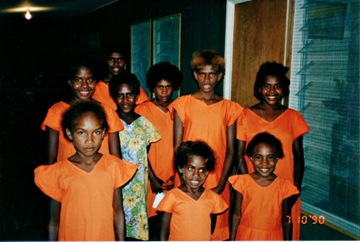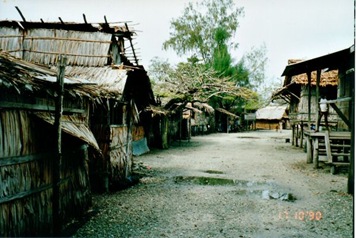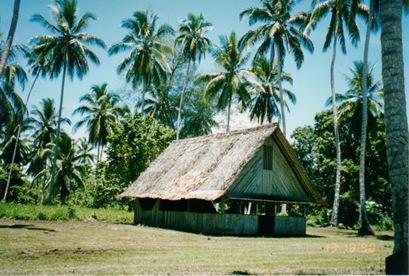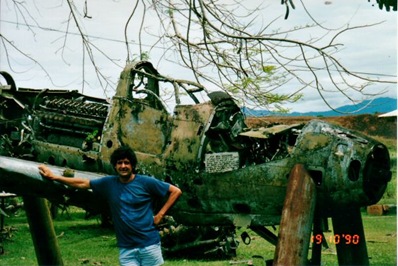Reading Mister Pip brought back memories of a holiday B and I had in 1990 where we spent two weeks in the Solomon Islands.
It was a very interesting and unusual holiday and was brought about at the instigation of my Uncle Lenny who lived there. He had gone to the Solomons shortly after the war, having fallen in love with the idea of the fuzzy wuzzy angels who had helped the Australian and American armies during the battle for Guadalcanal.
Uncle Lenny was my father’s third youngest brother (there were seven brothers in all) and had volunteered for the army in 1939. He saw action in a number of the great battles of World War II – Greece, Crete and El Alamein. He was wounded three times and eventually was sent home as unfit for service.
After the war Lenny found a vocation for missionary work and eventually became a Marist brother and took up his work in the Solomon Islands. He remained there for over 40 years until his death in 2000.
He was my favourite uncle during my childhood as he always bought me a book whenever he visited. He maintained a friendship with my mother throughout the years after my father’s death in 1949.
Anyway, Lenny was always inviting us to visit and stay with him in the Solomons so eventually I decided to go.
When we alighted from the plane at Henderson airport on Guadalcanal, notwithstanding being hit with the heat of the tropics, we were plunged into a kind of tropical Father Ted show. We were whisked off to a nun’s house and fed a ghastly repast which we felt obliged to eat even though we’d eaten plenty on the plane. It consisted of pretty basic fare like spam in aspic. In fact the food in the Solomon Islands was nothing to write home about as meat was scarce and had to be imported from Australia. Of course there were pigs and chickens all over the place but they were being saved for special celebrations. We didn’t get to eat any of them, except when Sister whatever cooked us a roast chicken which we transported in its pan back to the uncle’s place over miles of bumpy roads, the grease slopping everywhere.

Lenny's House at Aruligo
Uncle Len lived at a place called Aruligo which is at the north western end of the island about a half hour drive from Honiara. It was beautiful, a tropical paradise by the sea, overlooking Savo Island and Iron Bottom Sound where battleships of World War II were strewn in great numbers under the water. Aruligo was used as a setting in the film The Thin Red Line. Lenny was the only white person there, living by a native village and a small coconut plantation.

The Welcoming Choir - Justina is the girl at the back on the right
When we reached Aruligo that first night we were greeted by the village and welcomed with a song and dance organised by Lenny’s housekeeper, the wonderful Justina. She was a young woman of the village and was an incredibly sweet person. She was multi skilled - she could even drive a truck. Trucks were the primary method of transport in the Solomon Islands because you could fit half a village in the tray of the vehicle.

Truck transport
As my uncle was of the religious brotherhood, we hobnobbed with a variety of priests and even the Catholic Bishop of the Solomon Islands. They were an extraordinary collection of characters, these priests, and friendly, interesting guys. B, having no religious background, unlike me who was pretty well raised in convents, was initially somewhat nonplussed at meeting so many of the Catholic fraternity, but relaxed when he realised they were laid back guys who enjoyed a beer with best.

Malaitan village on an island on Langa Langa Lagoon
We visited priests in outposts further from Aruligo. There was Father Percy who welcomed us with a cigarette in one hand and a whisky in the other, calling on the native boys to stuff beer in his fridge, and another who lived on Malaita Island.

View from behind pilot on the way to Malaita
We flew to Malaita on a tiny plane sitting directly behind the pilot. It was quite an amazing flight and it was hard to believe how we could land on a small clearing cut out of the jungle which was indeed Malaita airport. Whilst there we took a trip to Langa Langa lagoon, which is dotted with man made islands. In Malaita there is a cult of shark calling, though we didn’t witness this. B however had a close encounter with a coral shark while snorkelling off the reef close to Aruligo. When asked about sharks in the area, the native people would just laugh as if the answer was obvious. Coming back from Malaita we travelled on the Compass Rose a cargo cum passenger vessel laden with bananas, coconuts and pineapples as well as betel nut chewing natives. We were the only white folk on board. From the deck you could see flying fish and dolphins, but down below, to which we were eventually obliged to descend due to the wind, it was muggy and we passed the five hour voyage in a fug of tropical heat watching the rituals of betel nut ingestion. A stick of coral is stirred into the mix to add a touch of lime. The betel nut chewers are distinguished by dreadfully stained teeth. I was not tempted to try it.

Native hut
The Melanesian people of the Solomon Islands are lovely folk, happy and friendly. We were treated like vice regal visitors in the outlying villages. Everyone knew Lenny and his welcome was extended to us.
The current political troubles had not started when we were there in 1990, though there was an undercurrent of dislike on the part of the Guadalcanal people for the Malaitans.

The view from Lenny's veranda - Savo Island is in the distance
Lenny’s house in Aruligo was right next to the sea. It had no beach; the land running directly into the sea, with the coconut palms marching straight to the edge. The water was warm and clear. Close to the water’s edge was a fresh, and cool, small spring-fed pool. The local villagers used it to wash their clothes and themselves and I preferred swimming in it to the ocean.
B & I slept on camp stretchers. In the night we could hear giant cockroaches scuttling between us and the chirping of the geckos permeated the night air. I liked the geckos; they were about the only wild life, other than cane toads, that we saw in any great quantity.
There are a great many relics of the battle for Guadalcanal lying around in the jungle and we visited a small museum which was maintained by an evangelical fellow. He had a collection of old aeroplanes and other military equipment.

B leaning against an old plane from World War II at outdoor museum
It was hot of course, but in the afternoon the sea breezes cooled us as we lounged on the veranda of Lenny’s sea side house. After dark, mosquitoes were out in force and I managed to get a small tropical ulcer after a bite became infected. The natives were all more or less prone to malaria and tropical ulcers, some of which were horrific to behold – gaping wounds where the ulcer had penetrated almost to the bone. Lenny had a sort of clinic going on Sunday after mass where he dispensed malaria tablets and dressed wounds. B helped him during the time we were there and won the gratitude of the people.

Waiting for medical treatment on Lenny's veranda - Lenny is standing on the left
Flywire screens were de rigueur as were louvered windows in all the houses we visited – the flywire to stop the mossies and louvers for primitive air conditioning.
It was a laid back place, everyone did things slowly and it took forever to get anything fixed. For instance, Lenny’s electricity generator was working the first night we were there, and then broke down. It was fixed two weeks later on the day before we left. It made cooking rather difficult as there was only a gas hotplate. Somehow or other – B and I took over the cooking shortly after we arrived – we managed by balancing saucepans on top of each other. We ate a lot of salads.
On our last night at Aruligo the village people cooked us up a feast which consisted of fish and various other native delicacies, all of which were very tasty. They also put on a show of dancing which they found hilarious and we found amusing.

Dancer
Despite the primitive accommodation and the tropical heat, we were both very sorry to leave, having grown very fond of the villagers. Driven by Justina, the entire village piled into the truck and came to the airport to see us off. We were touched by this gesture and the hostess ushering us on board the plane was impressed.

The farewell committee at the airport
B reckons it was best holiday he’s ever had and I agree. It was certainly interesting and we were lucky to be able to meet so many of the people, visit different places and see so much local colour.
We also saw things we’d never seen before, like fireflies, flying fish and a hibiscus that changed colour as the day progressed. It started out white in morning and gradually grew more flushed until it was a deep red by late afternoon. Plant life was profuse – anything would grow in the rich soil. Coconut palms were everywhere and you had to be careful not to walk under them as a dropping coconut would kill in a flash if it landed on your head. They made a loud thump when they fell.
Solomon Islands culture, with its bloodthirsty past was typified by the deity Nguzunguzu who is represented as carrying a skull (for war) or a bird (for peace). Used as a figurehead on head hunting canoes, Nguzunguzu’s image is common. At the bishop’s house, in the dining room, there was a very fine carving of Nguzunguzu carrying a bird. He is also on the Solomon Island dollar coin.

Carving of Nguzunguzu
We have at home a carving of a devil devil given to us by Justina’s friend, Thomasina. She gave it to us as a going away present. It sits on top of a stereo speaker in our living room. I am unsure of what it actually means, but it looks attractively weird. Wood carvings of sharks and dolphins were easy to come by and very cheap. I bought several as presents for relatives.





















.JPG)




